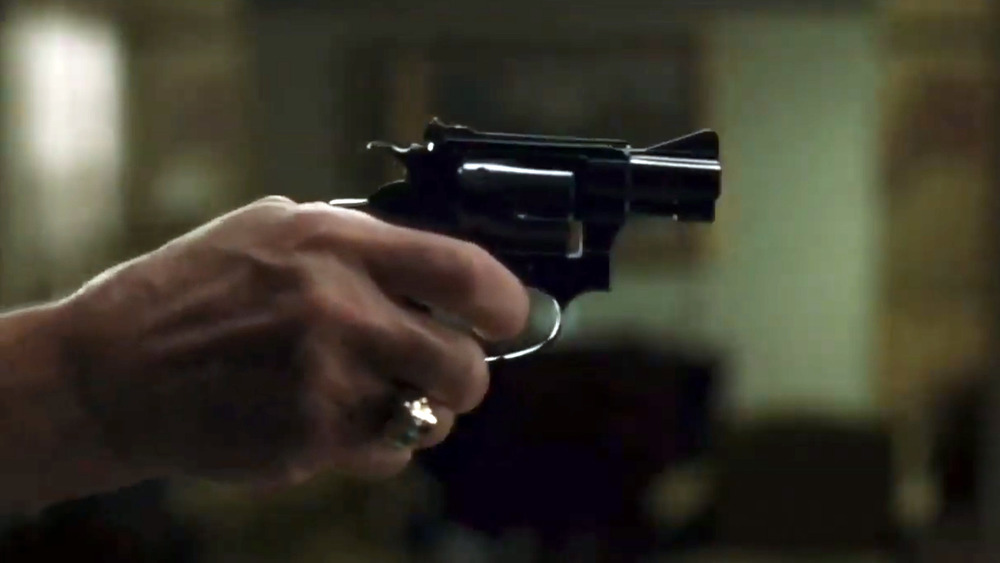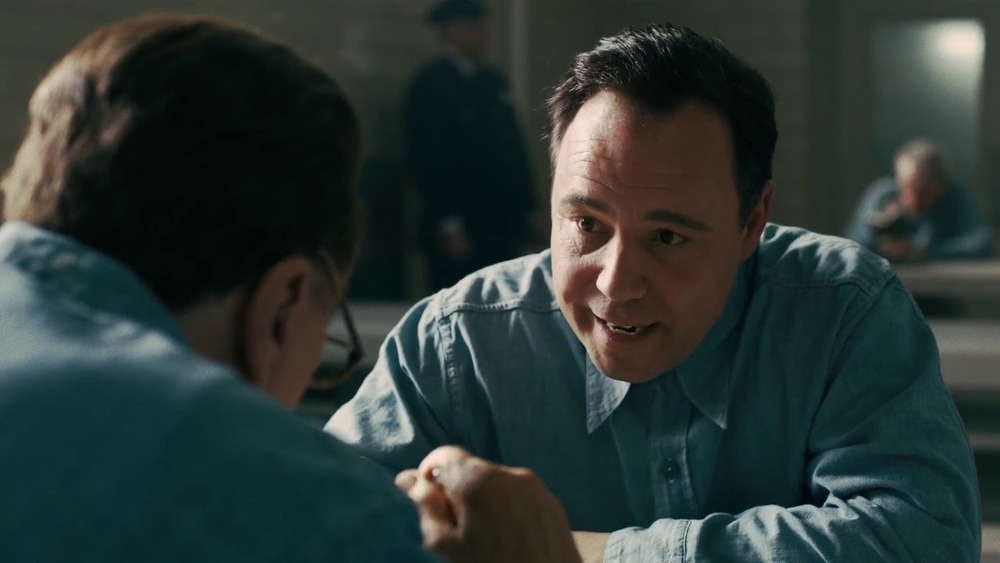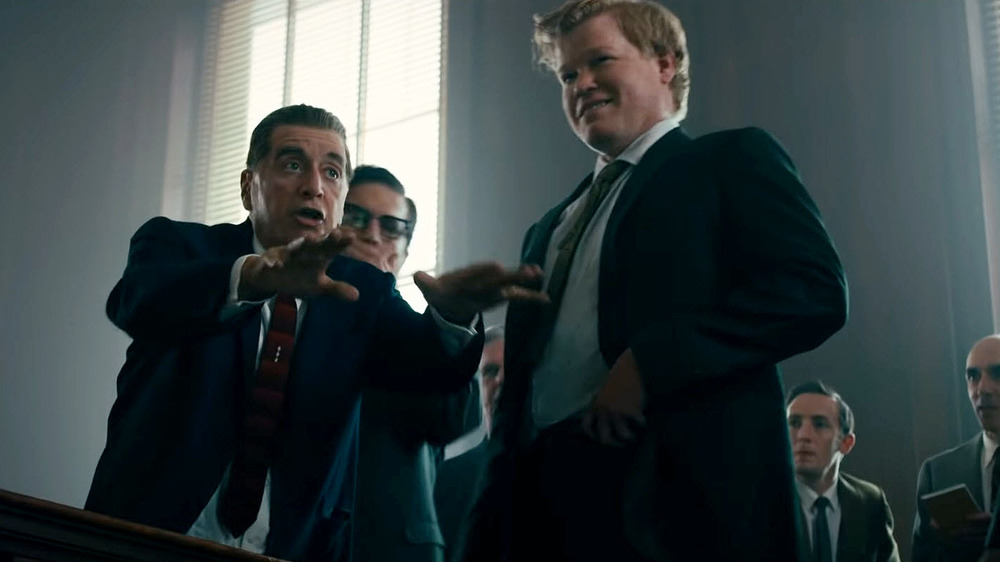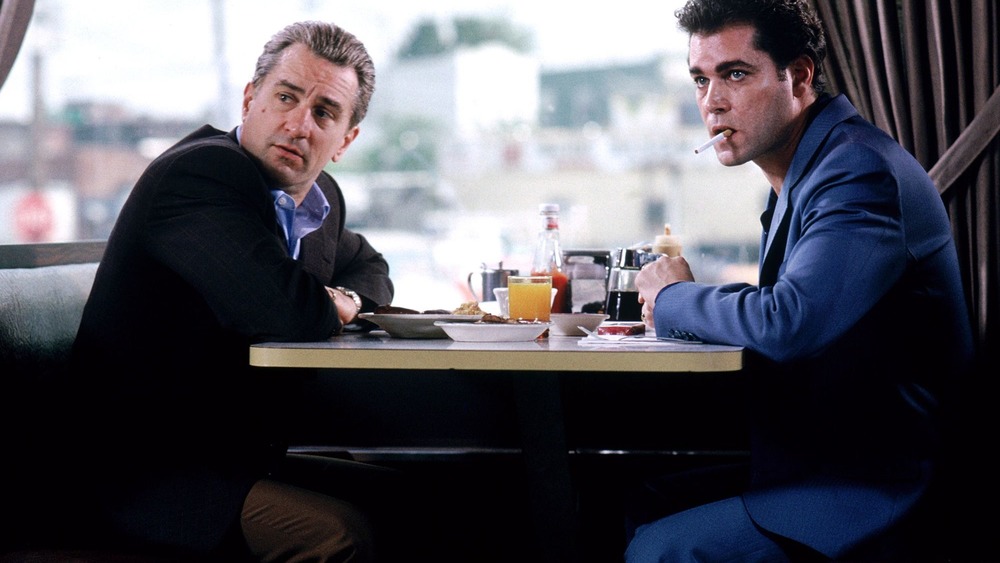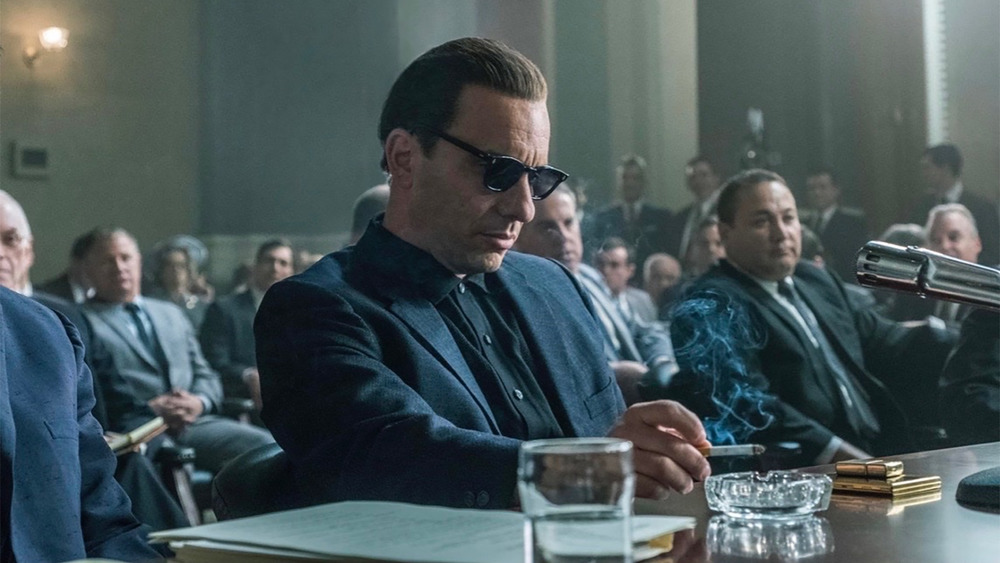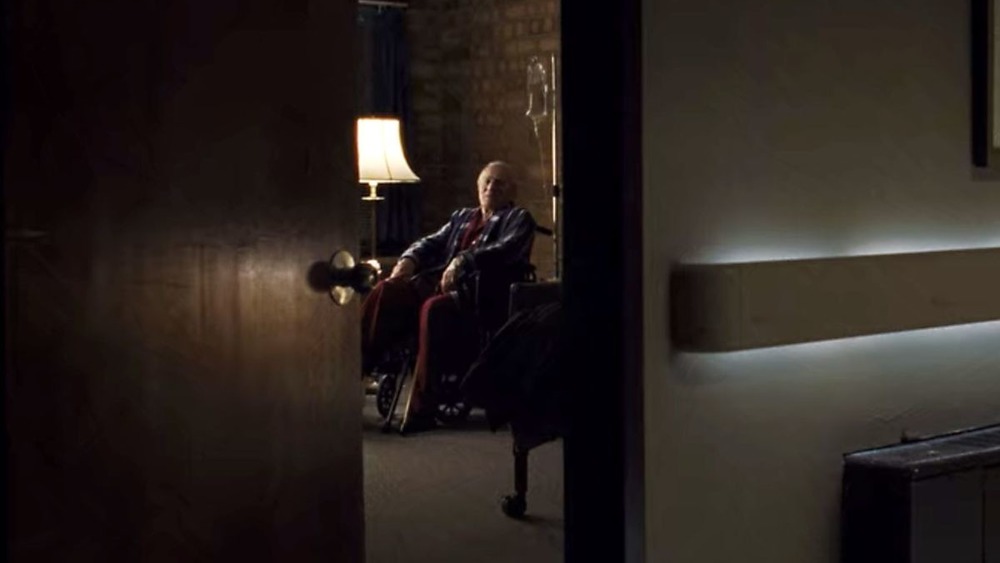Small Details You Missed In The Irishman
This content was paid for by Netflix and created by Looper.
There's a lot going on in The Irishman. At its heart, Martin Scorsese's latest gangland epic is an intimate and personal tale, chronicling the rise and fall of mob hitman Frank Sheeran and the numerous friends he made (and victims he whacked) along the way. And yet, according to Sheeran's own testimony, the story is so much more. It's a journey through six decades of organized crime in America, and ties together everything from the Bay of Pigs invasion to the Kennedy assassination to, most notably, Jimmy Hoffa's still-unsolved disappearance.
As a result, The Irishman has a cast filled with dozens and dozens of characters, multiple ongoing subplots, and constant references to major historical events. Throw in a script that jumps around the timeline at will, and it's almost too much to keep track of – almost.
While you may not pick up on everything on a first viewing, the world of The Irishman is full of detail, making every visit intoxicating. Even if you don't notice everything, all of those small references, callbacks, and Easter eggs add up, giving the story depth and texture while bringing Sheeran's wild, unbelievable story to life. So, here you go: These are just some of the small details that make The Irishman so special.
A literal blink-and-you'll-miss-it spoiler
The Irishman is a sprawling epic that spans multiple decades, but it all revolves around a single moment: the death of Jimmy Hoffa at the hand of his best friend, Frank Sheeran. Yes, there's plenty more movie after Hoffa meets his abrupt, violent end, but the Teamster leader's murder is what the entire movie builds to. It informs almost everything that comes both before and after.
And yet, Scorsese spoils the big climax in The Irishman's very first scene. Did you miss it? Go back and watch the opening of the movie again. After the long tracking shot through Sheeran's retirement home, the aging hitman looks at the camera and begins to tell his story. "I was a working guy," Sheeran says. "A business agent for Teamster Local One-O-Seven out of South Philadelphia. One of a thousand working stiffs, until I wasn't any more, and started painting houses myself."
Then, suddenly, there's a cut to a hand holding a gun. A shot rings out. A man falls to the ground, dead, blood splattering against the wall. Look familiar? If you've already seen The Irishman, it should. That's not a random victim. That's Jimmy Hoffa. You never see Al Pacino's face in the sequence, but the clothing, the hair, and the location all match those seen during Hoffa's full execution, which The Irishman shows in full about three hours later. Thankfully, the story is engrossing enough that you won't remember — or care — by the time the big moment comes around again.
Lewisburg prison, the discerning gangster's home away from home
Martin Scorsese likes to work with the same stars over and over, and sure enough, in The Irishman, you can see the likes of Robert De Niro, Joe Pesci, Harvey Kietel, as well as work from behind-the-scenes folks like Scorsese's regular editor Thelma Schoonmaker, casting director Ellen Lewis, and music supervisor Robbie Robertson. Still, unless you were paying attention to the scenery, you probably didn't notice the contribution from one of Scorsese's most frequent collaborators: The United States Penitentiary, Lewisburg, which has housed many of America's most notorious gangsters.
Lewisburg is where Jimmy Hoffa served his sentence for jury tampering, and where, as depicted in the movie, he lost his temper (and his ice cream) during an argument with Tony Pro. He's far from the first Scorsese protagonist to spend time in the Pennsylvania prison, though. In Goodfellas, Lewisburg is where Henry Hill spent his luxurious prison stay, cooking elaborate meals and yucking it up alongside boss Paulie Cicero (real name Paul Vario). The Irish gangster Whitey Bulger, who was the basis for Jack Nicholson's character in The Departed, stayed at Lewisburg for two years in the '60s. Bootlegger Enoch L. Johnson was sentenced to Lewisburg in 1941. He'd later go on to inspire Steve Buscemi's Nucky Thompson on HBO's Boardwalk Empire, which Scorsese directed and produced.
Over the years, Lewisburg has been home to plenty of other organized crime legends, too. John Gotti spent some time in the prison a few decades before taking over the Gambino crime family, while Al Capone "enjoyed" a brief stint at Lewisburg, as well.
Sheeran 1, kangaroo 0
If The Irishman proves anything, it's that Frank Sheeran loves to tell outrageous stories. No, not every yarn in I Hear You Paint Houses, the book that The Irishman is based on, is likely true, but they're all fascinating just the same. In fact, I Heard You Paint Houses is so full of tall tales that, even with The Irishman's extended runtime, there wasn't room to include all of them, meaning that many of the more colorful moments of Sheeran's life ended up on the cutting room floor.
For example, the time that Sheeran evaded the police by dressing up as an old woman? It's not there. Neither is Russell Buffalino's clash with Frank Sinatra ("Sit down or I'll rip out your tongue," Buffalino allegedly said), the time Sheeran hired boxer Joe Louis to greet Hoffa at court in order to curry favor with the mostly-Black jury, or the Teamster negotiations Sheeran influenced by slipping laxatives into his opponents' coffee.
Still, Sheeran's wildest story — other than killing Jimmy Hoffa, of course — does get a brief nod in the film. Before he became an assassin, Sheeran claims that he made $100 by boxing a kangaroo at a traveling carnival. According to Sheeran, that's actually when he met his first wife, who was a spectator in the stands. Sadly, that scene isn't in The Irishman, but you can see a photo of a man boxing a kangaroo hanging on the wall of Sheeran's office.
Sleeping (and driving) with the fishes
Before The Irishman, Al Pacino and Robert De Niro had only worked together a handful of times, but they'll be forever linked in the public consciousness thanks to a little movie called The Godfather Part II, which is considered both one of the best sequels and one of the very best movies of all time. Both actors appeared in the movie, although they didn't share any scenes together: While Pacino plays Michael Corleone in the 1950s, De Niro takes over as his father, Vito, for an origin story taking place in the 1910s.
But that's not all. The Irishman has another link to The Godfather — and it comes from one of the most unlikely characters. As he's written in Steve Zillian's script and played by Jesse Plemons, Chuckie O'Brien is a harmless, simple-minded man whose biggest claim to fame is being known as Hoffa's foster son. But in reality, O'Brien was actually a shrewd operator, and a key part of Hoffa's operation. In fact, O'Brien's stepson claims that it was Chuckie, not Frank Sheeran, who served as Hoffa's right-hand man.
Mario Puzo, author of The Godfather, seems to agree, because he based Corleone family consigliere Tom Hagen, played in the film by Robert Duvall, on O'Brien. Don't take Chuckie's hapless discussion about the fish in his car as a reference to The Godfather's most famous piece of dialogue, "Luca Brasi sleeps with the fishes." That's actually a nod to O'Brien's real-life alibi: As he convinced authorities, O'Brien couldn't have been involved in Hoffa's disappearance because he was busy delivering a fish to a fellow Teamster the same day.
Dining like a Goodfella
With Robert De Niro and Joe Pesci as leads, Martin Scorsese behind the camera, and a real-life crime story as its base, it's almost impossible not to think of Goodfellas while watching The Irishman. That's not necessarily a bad thing, either. Scorsese's 1990 drama single-handedly reinvented mob movies. Over 30 years after its debut, it's still considered one of his very best.
Given all that, it's not too surprising that there's a lot of overlap between the two movies. "Crazy" Joe Gallo gets namedropped in Goodfellas, and then appears in full in The Irishman, for example. And before filming The Irishman, Scorsese and De Niro recreated one of Goodfellas' most memorable scenes 25 years after filming it the first time, comparing the two versions after the fact to make sure The Irishman's digital de-aging tech was up to snuff. But the biggest crossover between the two movies? Why, that would be the Clinton Diner, the Queens eatery that appears in both movies.
In Goodfellas, the Clinton is where De Niro's Jimmy Conway learns that Pesci's character, Tommy DeVito, is dead, and later tries to lure Henry Hill to Florida, which (rightfully) convinces Hill that his life is in danger. In The Irishman, it's where Sheeran meets with Whispers DiTullio about the job that puts him on Angelo Bruno's radar, drawing him deeper into the criminal underworld. Just don't plan on visiting the diner yourself. The location, which changed its name to The Goodfellas Diner after its appearance in the movie, caught fire in 2018, right after production on The Irishman wrapped.
The secret of Joe Gallo's demise
The Irishman wastes no time in establishing Joe Gallo, played in the film by Sebastian Maniscalco, as a loose cannon. In his first few minutes on screen, Scorsese establishes that Gallo as a flippant livewire who kidnapped his own bosses and started a gang war, welcomes any and all press conferences, and, after a lengthy stay in prison, doesn't seem to answer to anybody — including Russell Bufalino.
"Hey, whaddya doin' with that?" Gallo asks Russell at the Copacabana nightclub, flicking the mobster's Italian-American Civil Rights League pin. "You really believe in that?" In that moment, it's crystal clear: Gallo has to go.
Gallo's assassination is about much more than his disrespectful fashion critique, though, and has everything to do with the scene that comes just before this encounter. In 1971, Jerome A. Johnson shot mob boss Joseph Colombo three times while he was speaking at a rally for the Italian-American Civil Rights League, an organization founded to combat the negative images of Italian-Americans in the media, including films like The Godfather. Colombo survived, but was paralyzed for the rest of his life.
While the police concluded that Johnson was acting alone, many members of the criminal underworld presumed that Gallo, who'd had a falling out with Colombo, was behind the hit. As such, when Gallo needles Bufalino about the pin, he's not just being a wiseguy. He's shamelessly flaunting his impropriety. No wonder Russell wants him dead.
If it's good enough for Jimmy Hoffa...
Al Pacino's Jimmy Hoffa has good reason to be paranoid. The government, embodied by crusading Attorney General Bobby Kennedy, is out to put him in prison. Tony Pro is after his throne. His relationship with the mob is shaky at best. As his tragic end shows, he can't even trust his best friend.
As such, you can hardly blame him for sleeping with the door open. It's a habit that Frank notices on the night of his first meeting with Hoffa, when they're sharing a suite at Chicago's historic Edgewater hotel. As Sheeran describes, Hoffa doesn't want Frank registering at the hotel under his own name. So, he sleeps on the couch, while Hoffa puts on his pajamas and slips into the bedroom, leaving his door ajar.
It's a small moment, but it pays off in a big way at the end of the movie. After Sheeran has finished telling his story, he visits with a priest, looking for forgiveness from his sins. "Father, could you do me a favor?" he asks, as the priest leaves. "Don't close the door all the way. I don't like that. Leave it open a little." The holy man obliges. And that's how we last see Frank Sheeran: resting behind a door that's slightly ajar, just like the friend he betrayed.
